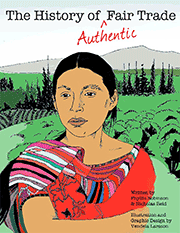
Cashew fruit smells and tastes sweet, almost like an apple, but can also be slightly astringent. It bruises easily so isn’t often sold whole, but rather is made into a delicious fruit juice.
Today in San Nicholas Lempa, Department of Usulutan, El Salvador, the staff of Aprainores, a 55-member cashew nut co-operative, is loading up approximately 12,000 pounds of cashew nuts and driving them to the port in Acajutla. They will leave El Salvador this Saturday and arrive at the Equal Exchange warehouse in Portland, Oregon sometime in mid-January. Soon after that, the cashews will be sold in natural food stores across the United States.
This is Equal Exchange’s first shipment of cashew nuts and we couldn’t be more excited! I couldn’t be more excited either; I’ve just returned yesterday from El Salvador where I was visiting Aprainores. Over the next few days, I will be writing a lot about this co-op and sharing many photos of the farms, producers, and countryside where they are grown. (We will soon also be selling cashews from Kerala, India, as well; but that’s another story.)
Think about it… this holiday season many of us will be snacking on nuts and dried fruits.
How much do we know about where they are from, who grows them, and under what conditions? Regardless of whether we make our purchases in a supermarket, Whole Foods, Trader Joes, or a natural food store, chances are we are not given very much information about the products’ origin.
Thankfully, many consumers are now interested in knowing the story behind the coffee, tea, chocolate, and produce which they purchase. We think it’s high time that this same information be made available about nuts and dried fruits so that consumers have both information and choices. We are also excited to give the same level of attention; and respect; to the farmers who produce them.
There’s much to share, but it occurred to me that many people have never seen a cashew nut fruit or a cashew nut tree. So today’s blog post starts with the basics.
Enjoy!

Cashew nut tree farms on the Isle of Montecristo where 15 members of Aprainores live. The trees are 80 – 100 years old.

These trees were all planted by a german landowner, Luz Draico, who owned the island, a neighboring island, Tasajera, and what is now two communities on the mainland, La Canoa and El Naranjo.
The harvest typically begins in late December.

First, little purple flowers bloom. About a week later, the nut appears.

Next, what appears to be a brown stem, is actually the fruit beginning to grow.

The fruit ripens approximately six weeks after the flowers come out.

Cashew fruit can by yellow or red.

Once ripe, the fruit falls to the ground. (It’s very important not to pick the fruit off the tree or it will damage the following year’s harvest.) The farmers pick the fruit up off the ground, remove the cashew nuts and bring them back to their houses where they dry them in the sun for three days before sending them in motor boats to Aprainores for further processing. The farmers keep the fruit to make a refreshing drink for their own consumption.


Leopoldo Rafael Abrego, on his farm in El Naranjo.
Read Full Post »














